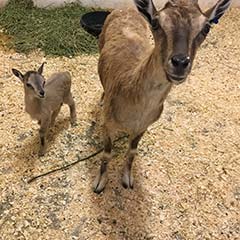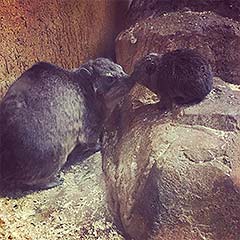Summer baby boom at Stone Zoo!
Wednesday August 2, 2017
Visitors to Stone Zoo will notice several new furry faces with the recent birth of a markhor, a mountain goat species native to the Himalayas, and rock hyrax babies.
 The female markhor was born on July 16 to parents Maya and Tyrion, and can be seen on exhibit within the Himalayan Highlands. Stone Zoo is home to 10 markhor, including the new kid.
The female markhor was born on July 16 to parents Maya and Tyrion, and can be seen on exhibit within the Himalayan Highlands. Stone Zoo is home to 10 markhor, including the new kid.
The markhor kid, who weighs 8.8 pounds, recently had her first exam and she appears to be in good health.
“Maya is very attentive to the kid, who has been nursing well and is strong and active. As with any new birth, we are closely monitoring the mother and baby,” said Dr. Alex Becket, Zoo New England Associate Veterinarian in the department of Animal Health and Conservation Medicine.
Zoo New England participates in the Markhor Species Survival Plan (SSP), which is a cooperative, inter-zoo program coordinated nationally through the Association of Zoos and Aquariums (AZA). SSPs are designed to maintain genetically diverse and demographically stable captive populations of species. This birth is the result of a recommended breeding.
Markhors are native to the Himalayan Mountains. Their range includes northern India, Pakistan, and Afghanistan, and they can typically be found living around or above the tree line. The largest of the wild goat species, markhor have broad hooves and striking spiral horns that can grow to three feet long in mature males. In the wild, this species faces a number of threats including hunting as well as competition for food. The long corkscrew horns that males develop as they mature are much sought after by trophy hunters. These animals are also competing against domestic livestock for food and water resources in their native habitat. Zoo New England has supported a project in Pakistan that works with local communities to sustainably manage markhor and other wildlife.
 Several days after the markhor was born, Paprika, a rock hyrax, gave birth to three pups. The pups can be seen on exhibit with their mother, father Marco and two older siblings. The meerkats, who share their exhibit space with the rock hyraxes, will not be on exhibit while the pups adjust to their surroundings.
Several days after the markhor was born, Paprika, a rock hyrax, gave birth to three pups. The pups can be seen on exhibit with their mother, father Marco and two older siblings. The meerkats, who share their exhibit space with the rock hyraxes, will not be on exhibit while the pups adjust to their surroundings.
While rock hyrax may resemble rodents, these small mammals weighing between eight to 12 pounds are actually distantly related to elephants. Their skulls, teeth and toes are similar in structure to an elephant, and they even have tiny tusks. Native to the rocky scrublands, desert and rocky outcrops in the rainforests of sub-Saharan and northeast Africa, as well as the Arabian Peninsula, these small mammals are well adapted to rocky terrain and can live in groups of 50 to 80 animals.
Zoo New England participates in the Rock Hyrax SSP. These births were the result of a recommended breeding.
Photos courtesy of Bridget Collins Lyman

